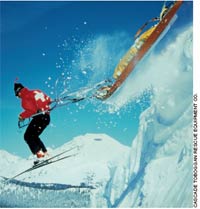
Blade Runners
These professionals take emergency care to new heights.
 Injury-free days on the slopes are few and
far between. To some extent, mishaps just
go with the terrain when millions of skiers
per season, people of all ages and skill
levels, are turned loose on snow and ice at
high altitudes with boards strapped to their
feet. It doesn’t help that snow has a tendency
to shift or that trail conditions can
change hourly.
Injury-free days on the slopes are few and
far between. To some extent, mishaps just
go with the terrain when millions of skiers
per season, people of all ages and skill
levels, are turned loose on snow and ice at
high altitudes with boards strapped to their
feet. It doesn’t help that snow has a tendency
to shift or that trail conditions can
change hourly.
From a safety professional’s perspective,
the recreational mix that takes place on
America’s mountains for roughly half of
every year might seem to provide the
ingredients for a good, six-month-long
migraine. Yet the men and women charged
with keeping track of that shifting snow
and responding with immediate care when
incidents occur say their jobs are uplifting
in ways that have nothing to do with the
on-site gondolas and T-bar pulls.
The National Ski Patrol, a federally
chartered nonprofit association now celebrating
its 70th year, says it represents 98
percent of the patrollers in the United
States. NSP Executive Director Tim
White notes that, of the association’s
27,000 members, a full 24,000 are volunteers
who, for often little remuneration,
take it upon themselves to complete extensive
training and then give of their time for
the opportunity to join their local team and
serve at sites across the country, virtually
anywhere there’s a chair lift. “If it’s a ski
area, then it has patrollers. And there is a
shack somewhere on the hill, and they’re in
it waiting to be called,” he says.
The Hills Have Eyes
Before they ever make it to that shack on
the hill, patrollers have to complete the
association’s Outdoor Emergency Care
training program, essentially an 80- to 100-
hour EMT education focused on outdoor
environments, followed by additional skills
training at their individual “hills” or work
sites. NSP also requires the completion of
refresher courses every year.
“We do a lot of training. In fact, we
never stop training,” says Craig Simson,
assistant patrol director at Keystone Resort
in Colorado. “Every week we have a different
focus.” One week it might be
avalanche training, detailing the finer
points of skiing with the explosives necessary
for mitigating natural slides that could
occur in avalanche-prone
areas; other weeks might
focus on what to do in the
unlikely event of a chair lift
breaking, or other rescue
and recovery techniques.
“Most people don’t
understand the extent of
what we do,” Simson says.
“Our largest priority is medical
response—that is, in
fact, the beginning of the
whole thing—but we’re also
basically the police out
there, enforcing the Ski
Safety Act and skiers’
responsibilities, and we take
care of trail maintenance. . . .
We are in the game of delivering
a whole bunch of
people into an element they
perhaps aren’t used to, and in that we spend
a tremendous amount of time trying to
make it the best and safest experience possible
for them.”
Ed Strapp, a patroller at Maine’s Sugarloaf
Ski Area, describes the job as being
similar to that of other emergency medical
service providers, but with additional challenges.
“Our main responsibility, just like
in EMS, is we get on the scene, we establish
what the injuries are, and we stabilize
the patient,” he says. “But often we’re
doing this on 45-degree icy slopes, and
rather than extricating from a car, our
extrications are from trees, bushes, and
things like that.”
Once patrollers have a patient safely
strapped in a toboggan, they face the additional
challenge of skiing with it back down
the mountain for more definitive care,
without additional injury. “It can be a 10-
or 15-minute transport time off some
mountains,” Strapp says. “We don’t just lift
them up and slide them in the back of an
ambulance. We have to get them off the
hill, and, in effect, we are the ambulance.”
Just Say Snow
Being a human ambulance requires being
in good shape, both physically and mentally.
“I would call it a job for which you
can’t let your guard down,” Simson says.
“Just skiing alone has its own inherent
risks, but then on top of that we are skiing
sometimes with explosives, or we’re skiing
with toboggans. . . . It’s a lot of responsibility,
so we’re very picky about who wears
the uniform and who is going to be taking
care of folks out there.”
Dennis McMahan, patrol director at
the Freeland, Mich.-based Apple Mountain
Ski Resort, agrees that it takes a person
of special caliber to volunteer for the work.
“When you’re out there in minus-10-
degree weather and you’ve got a 40-mileper-
hour wind chill, a lot of people don’t
like to do that for free,” he says. “It’s a
matter of commitment. You go out and do
it because you like doing it and you enjoy
the sport. You’re not there for the pay or
the good hours and the sunny weather.
You’re just there because you can make a
difference.”
This article originally appeared in the April 2008 issue of Occupational Health & Safety.